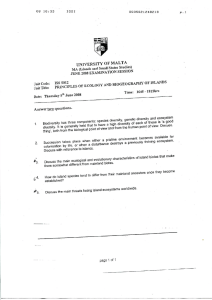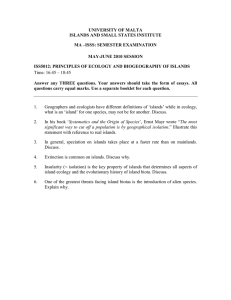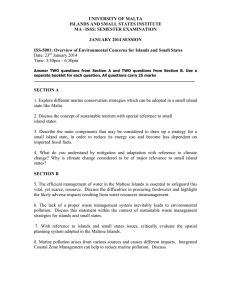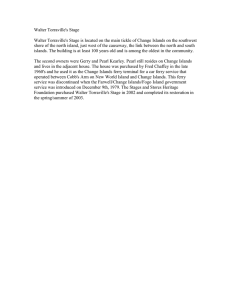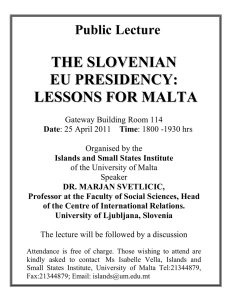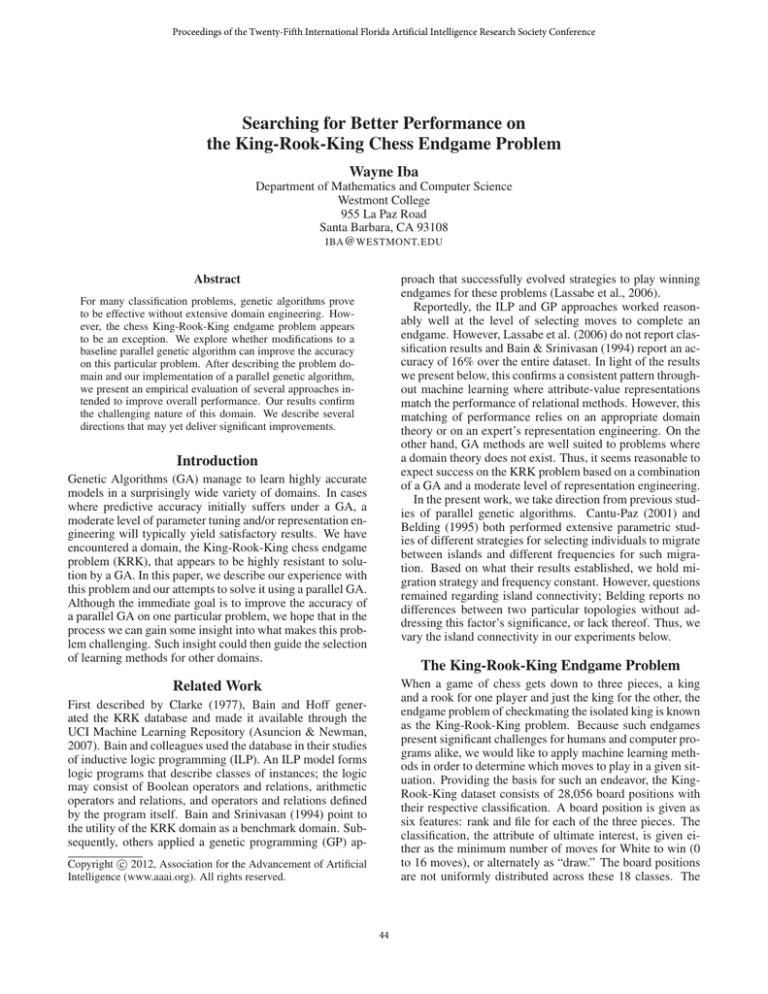
Proceedings of the Twenty-Fifth International Florida Artificial Intelligence Research Society Conference
Searching for Better Performance on
the King-Rook-King Chess Endgame Problem
Wayne Iba
Department of Mathematics and Computer Science
Westmont College
955 La Paz Road
Santa Barbara, CA 93108
IBA @ WESTMONT. EDU
Abstract
proach that successfully evolved strategies to play winning
endgames for these problems (Lassabe et al., 2006).
Reportedly, the ILP and GP approaches worked reasonably well at the level of selecting moves to complete an
endgame. However, Lassabe et al. (2006) do not report classification results and Bain & Srinivasan (1994) report an accuracy of 16% over the entire dataset. In light of the results
we present below, this confirms a consistent pattern throughout machine learning where attribute-value representations
match the performance of relational methods. However, this
matching of performance relies on an appropriate domain
theory or on an expert’s representation engineering. On the
other hand, GA methods are well suited to problems where
a domain theory does not exist. Thus, it seems reasonable to
expect success on the KRK problem based on a combination
of a GA and a moderate level of representation engineering.
In the present work, we take direction from previous studies of parallel genetic algorithms. Cantu-Paz (2001) and
Belding (1995) both performed extensive parametric studies of different strategies for selecting individuals to migrate
between islands and different frequencies for such migration. Based on what their results established, we hold migration strategy and frequency constant. However, questions
remained regarding island connectivity; Belding reports no
differences between two particular topologies without addressing this factor’s significance, or lack thereof. Thus, we
vary the island connectivity in our experiments below.
For many classification problems, genetic algorithms prove
to be effective without extensive domain engineering. However, the chess King-Rook-King endgame problem appears
to be an exception. We explore whether modifications to a
baseline parallel genetic algorithm can improve the accuracy
on this particular problem. After describing the problem domain and our implementation of a parallel genetic algorithm,
we present an empirical evaluation of several approaches intended to improve overall performance. Our results confirm
the challenging nature of this domain. We describe several
directions that may yet deliver significant improvements.
Introduction
Genetic Algorithms (GA) manage to learn highly accurate
models in a surprisingly wide variety of domains. In cases
where predictive accuracy initially suffers under a GA, a
moderate level of parameter tuning and/or representation engineering will typically yield satisfactory results. We have
encountered a domain, the King-Rook-King chess endgame
problem (KRK), that appears to be highly resistant to solution by a GA. In this paper, we describe our experience with
this problem and our attempts to solve it using a parallel GA.
Although the immediate goal is to improve the accuracy of
a parallel GA on one particular problem, we hope that in the
process we can gain some insight into what makes this problem challenging. Such insight could then guide the selection
of learning methods for other domains.
The King-Rook-King Endgame Problem
When a game of chess gets down to three pieces, a king
and a rook for one player and just the king for the other, the
endgame problem of checkmating the isolated king is known
as the King-Rook-King problem. Because such endgames
present significant challenges for humans and computer programs alike, we would like to apply machine learning methods in order to determine which moves to play in a given situation. Providing the basis for such an endeavor, the KingRook-King dataset consists of 28,056 board positions with
their respective classification. A board position is given as
six features: rank and file for each of the three pieces. The
classification, the attribute of ultimate interest, is given either as the minimum number of moves for White to win (0
to 16 moves), or alternately as “draw.” The board positions
are not uniformly distributed across these 18 classes. The
Related Work
First described by Clarke (1977), Bain and Hoff generated the KRK database and made it available through the
UCI Machine Learning Repository (Asuncion & Newman,
2007). Bain and colleagues used the database in their studies
of inductive logic programming (ILP). An ILP model forms
logic programs that describe classes of instances; the logic
may consist of Boolean operators and relations, arithmetic
operators and relations, and operators and relations defined
by the program itself. Bain and Srinivasan (1994) point to
the utility of the KRK domain as a benchmark domain. Subsequently, others applied a genetic programming (GP) apc 2012, Association for the Advancement of Artificial
Copyright Intelligence (www.aaai.org). All rights reserved.
44
distribution ranges from 27 board positions for the smallest
class up to 4,553 for the most frequent class. This suggests
a baseline accuracy of 16.2% by guessing the most frequent
class1 . However, our implementation does not take advantage of this fact and starts with a random accuracy on the
order of 5.5%.
One of the strengths of ILP systems is their ability to effectively create features that are derived from the raw attribute values. This is also a reason that such methods have
been successfully applied to the KRK domain. Assuming
that some feature engineering would be necessary, we added
six additional attributes representing the absolute distance
between each pair of pieces in terms of rank and file (Iba,
Marshman & Fisk, 2008). Note, we represent the distance
between two pieces on the same rank or file as a 1 so that our
rule-matching scheme can identify such conditions. Thus,
these values range from 1 to 8 for differences of 0 to 7. Below, we describe additional features we added in search of
improved performance in this problem domain.
to occur when an individual’s feature pattern includes a 1bit in the position of the instance’s feature. For example, if
an individual has a pattern [01101100] for the white king’s
rank, and an endgame problem has the white king in the third
rank – represented as [00000100] – we find a match when we
mask these together. These bit-mask patterns (as well as our
representation of the attributes of an instance) require one
byte each. In the baseline implementation, an individual’s
genetic code consists of 1,728 bits; that is, a byte for each of
the 12 features multiplied by 18 classes.
Our experience with this system on the KRK problem motivated us to explore ways to improve the overall accuracy.
In the next section we describe the steps we implemented
toward this end and in the following section we present our
results from those changes.
Attempts to Improve Performance
Our efforts to improve the performance of the system on the
KRK problem involved two categories of issues. The first
addressed a more comprehensive evaluation of the full range
of system parameters. The second explored additional features with which to represent instances.
Baseline Implementation
For this study, we use an extension of the island, or coarsegrained, GA model for parallel genetic algorithms (Iba et al.,
2008). In this standard approach, we partition the population of individuals over a collection of semi-isolated islands,
which map to separate processors. On each island, the local population evolves according to the traditional GA. Periodically, a relatively small number of selected individuals
migrate between islands, thereby infusing their genetic material into another island’s population. In this manner, we
obtain much of the benefit of a larger population at a fraction of the cost; we generally observe savings proportional
to the number of islands, which are simulated on separate
processors. In a previous study, we varied migrant selection
strategy and migration topology (Iba et al., 2008). Finding
no significant differences between migrant selection strategies, here we consistently use the fitness-proportionate migration strategy (Cantu-Paz, 2001). In our current search for
improved accuracy, we do vary the island connectivity and
several other system parameters described in the next section. However, we are not focused on the parallel aspects of
the implementation. Rather, we rely on parallelism in order
to reduce the overall run-time of our experiments.
An individual’s genome consists of 18 groups of multiple patterns, one for each possible classification. Each of
the patterns within a group matches against one corresponding feature of a board position. The group having the most
pattern matches determines the prediction made for a given
endgame position. We compute an individual’s fitness as the
fraction of board positions in the training set that it correctly
classifies. Given that we represent the features of endgame
instances by setting the bit to 1 in the corresponding position of each feature, we treat the patterns in an individual’s
genome as bit-masks. A positive match for a feature is said
System parameters
We evaluated a wide range of values for the mutation parameter. These tests did not reveal any significant differences or improvements. Therefore, we do not show results
for these variations. Subsequent tests hold the mutation parameter constant at 0.01 (i.e., approximately one individual
out of one-hundred will experience a single point-mutation).
After our previous study, we implemented additional
crossover reproduction settings. Based on the observed improvement from one to two crossover points and realizing
the genetic code of each individual consists of well over
1,500 bits, we implemented a variable crossover strategy to
increase genetic mixing. Two individuals that are selected
to reproduce will have anywhere from one crossover point
up to a maximum value, which we vary between 5 and 40.
We select the actual number of crossover points for a particular pairing of two individuals from a uniform distribution
between 1 and the maximum number.
We also considered the role of migration strategy and island connectivity in our previous study. Here, we do not vary
the method for selecting individuals to migrate, always using
the fitness-proportionate selection (Cantu-Paz, 2001). However, we do explore how the migrants that are selected get
distributed to other islands. For a fixed number of migrants,
we evaluate dividing them among any number of neighbors
between one and four.
Numerous researchers have established the similarity between one large population with n individuals and k smaller
populations, each with n/k individuals. Here, we vary
the value of k (islands), partly in order to confirm that the
performance from the parallel GA corresponds to that of
the canonical method, but also partly to decrease the time
needed to complete experiments. We want to use as many
islands as possible in order to maximize the speedup from
our parallel implementation without losing predictive accu-
1
Note that the similarity of this number to the accuracy reported
by Bain & Srinivasan (1994) is completely circumstantial. Their
method makes reasonable classifications and does not rely on frequency weighting.
45
07
racy. Lastly, we also vary population size with the expectation that accuracy will increase as we increase total number
of individuals.
06
05
Accuracy
Additional attributes
Unsatisfied with overall improvements from system tuning, we looked for alternative features that we could add
to the representations of instances and individuals. As described earlier, we already added six features representing
the distance between pairs of pieces, bringing the total to
twelve features. We also created several additional features.
Because checkmating the black king relies on trapping it
against the edge or corner, we include features for the Manhattan distance to the nearest corner and the straight-line distance to the nearest edge. In addition, we included a feature
that captures the Manhattan distance between the kings. Finally, we created features that combine the distance of the
black king to the nearest corner with the distance between
the kings (separately for rank and file).
04
03
02
Max-cross 5
Max-cross 10
Max-cross 20
Max-cross 40
01
0
1000
2000
3000
Generation
4000
5000
Figure 1: Fitness values for the best individuals over the
training set in the Chess Endgame problem comparing maximum crossover rates of 5, 10, 20 and 40 for a population of
3,200 individuals spread over eight islands.
Empirical Results
Island topology
Conventional wisdom establishes that only a small number
of migrants are necessary to accrue the benefit from the parallel island model. In addition, limited or local connectivity
has been shown to approach the performance of fully connected topologies. Thus, we face a tradeoff in terms of the
number of migrants moving between islands, the number of
immediately adjacent islands, and the degree to which we
approach the performance of a single monolithic population.
As an attempt to ensure that the number of neighboring islands had no significant impact on learning behavior, we
tested a number of different values of this parameter. We
expected to find comparable results over a range of connectivity values.
Figure 3 displays the fitness values of the best individuals
for five levels of island interconnectedness. In each case, 24
individuals are selected to migrate and are divided evenly
between either one, two, three, four or six neighbors. As
before, we measure the fitness of individuals over the training set of 1,000 instances; Figure 4 reports the predictive
accuracy for the best individuals measured over the entire
dataset.
In agreement with our hypothesis, these results show that
the dispersal of migrants has no significant impact on accuracy. Seeing no difference between the conditions, we use
only two neighbors for our subsequent experiments unless
noted otherwise.
We ran the following experiments on a 32-node cluster computer consisting of 2.8 Ghz Pentium 4 processors, communicating with each other over a gigabit switch. We have written
our code in C++ using the MPI library. For all experiments,
our training set consists of 1000 random samples from the
full dataset of 28K instances. We use this sample to determine the fitness of individuals for the purposes of survival,
breeding, and migration. However, we periodically evaluated the accuracy of the population over the entire dataset.
For these experiments, we hold the mutation rate constant at
0.01. Unless otherwise noted, we used eight islands with
populations of 400 individuals on each island, for a total
population of 3,200 individuals. The migration interval after
which selected migrants move between islands is held fixed
at 20 generations.
Crossover breeding
In our previous study (Iba et al., 2008), we considered only
single and double crossover reproduction. We hypothesized
that the length of the genome in our individuals resulted
in these crossover values taking insufficiently large steps
through the space of models and that higher values would
improve learning. To measure the potential benefit from an
increased crossover rate, we tested the system with four values of maximum crossover. Figure 1 shows the fitness values
for the most fit individuals (across all islands) under maximum crossover values of 5, 10, 20 and 40. We compute
these fitness values over the training set of 1,000 instances;
for the most fit individuals, Figure 2 reports their accuracy
over the entire dataset.
From the figures, we see that increasing crossover rate
improves performance up to a point. However, continued
increase from 20 to 40 does not provide a benefit and may
deteriorate performance. For subsequent experiments, we
hold the maximum crossover rate constant at 20.
Population size and distribution
To ensure that we were not sacrificing performance by resorting to a parallel GA, we varied the distribution of the
population over differing numbers of islands. Figure 5
shows the best individuals from a total population when distributed over 8, 16, and 32 islands. Figure 6 shows the best
individuals over the entire dataset.
Although the accuracies for 8 and 16 islands are quite
similar, we see an unusual result for 32 islands. On the
46
07
07
Max-cross 5
Max-cross 10
Max-cross 20
Max-cross 40
06
05
Accuracy
05
Accuracy
24 migrate to 1 neighbor
12 migrate to 2 neighbors
8 migrate to 3 neighbors
6 migrate to 4 neighbors
4 migrate to 6 neighbors
06
04
03
04
03
02
02
01
01
0
0
1000
2000
3000
Generation
4000
5000
1000
Figure 2: Classification accuracy of the best individuals over
the entire KRK dataset comparing maximum crossover rates
of 5, 10, 20 and 40 for a population of 3200 individuals
spread over eight islands.
2000
3000
Generation
4000
5000
Figure 4: Classification accuracy of the best individuals over
the entire KRK dataset for island connectivity values of 1, 2,
3, 4 and 6.
0.7
07
0.6
06
0.5
Accuracy
Accuracy
05
04
03
0.4
0.3
0.2
02
24 migrate to 1 neighbor
12 migrate to 2 neighbors
8 migrate to 3 neighbors
6 migrate to 4 neighbors
4 migrate to 6 neighbors
01
0
1000
2000
3000
Generation
4000
8 s ands of 400 nd v dua s
16 s ands of 200 nd v dua s
32 s ands of 100 nd v dua s
0.1
0
0
1000
5000
2000
3000
Generat on
4000
5000
Figure 5: Fitness values for the best individuals over the
training set in KRK domain shown for distributions of 3,200
individuals across 8, 16 and 32 islands.
Figure 3: Fitness values for the best individuals over the
training set in KRK domain shown for island connectivity
values of 1, 2, 3, 4 and 6.
case, we see that the larger population, when tested on the
full dataset, is not subject to the overfitting that we observe
in the condition with 100 individuals on 32 islands. Furthermore, we note that in the case of the larger population
performance on the sample training set is still improving after 5,000 generations whereas the condition with 32 islands
of 100 individuals has plateaued. Although the accuracy on
the full dataset improved slightly, we also note that the results are not drastically better than the 16 island condition
with 200 individuals on each.
sample set of 1,000 instances, the 32 island condition surpasses the other conditions by approximately five percentage
points. However, with respect to the full dataset, the same
condition performs about seven percentage points worse
than the others. We attribute this somewhat surprising result to overfitting. Because no other condition has given indications of overfitting, we did not expect this result. One
explanation points to the relationship between the migration
interval and the smaller population size in the 32-island condition. Perhaps with only 100 individuals, the local populations converge on local optima between migration intervals,
thereby discouraging search for more accurate and robust
models. However, this issue requires further investigation.
Finally, we also ran a test with a significantly larger total
population. Figure 7 compares the previous results with a
similar run where each of the 32 islands has a population of
400 giving a total population of 12,800 individuals. In this
Additional features
In all of the previous experiments, we represented board positions with twelve features as described above. For this experiment, we evaluated the contribution of the six features
we originally added as well as a number of other features
we are considering. To the extent that additional features
capture distinctive characteristics of the classes, we hypoth-
47
0.7
07
8 s ands of 400 nd v dua s
16 s ands of 200 nd v dua s
32 s ands of 100 nd v dua s
0.6
06
05
Accuracy
Accuracy
0.5
0.4
0.3
03
0.2
02
0.1
01
6 features
12 features
15 features
19 features
0
0
0
1000
2000
3000
Generat on
4000
0
5000
1000
2000
3000
Generation
4000
5000
Figure 8: Fitness values for the best individuals over the
training set in KRK domain shown for sets of 6, 12, 15 and
19 features.
Figure 6: Classification accuracy of the best individuals over
the entire KRK dataset for distributions of the total population among either 8, 16, or 32 islands.
07
0.7
6 features
12 features
15 features
19 features
06
0.6
05
Accuracy
0.5
Accuracy
04
0.4
0.3
04
03
02
0.2
32 s . of 400 nd v.
32 s . of 100 nd v.
32 s . of 400 nd v. (fu dataset)
32 s . of 100 nd v. (fu dataset)
0.1
0
0
1000
2000
3000
Generat on
4000
01
0
0
5000
1000
2000
3000
Generation
4000
5000
Figure 9: Classification accuracy of the best individuals over
the entire KRK dataset for sets of 6, 12, 15 and 19 features.
Figure 7: Fitness values of the best individuals over the
training set and classification accuracy over the entire KRK
dataset for total populations of 3,200 and 12,800 spread over
32 islands.
data and training to exercise this quality; likewise, providing
more degrees of freedom invites overfitting.
esized that adding informative features would provide representational leverage and improve classification accuracy.
Figure 8 compares runs using only the six features found
in the dataset, 12 features including the pairwise distances
between pieces, 15 features including the distance of the
black king to the nearest corner, and 19 features including
the combinations of distance to corner and distance between
kings. As before, we show the results over the entire dataset
in Figure 9. The curves reveal a significant benefit over the
original six features, but clearly diminishing returns as additional features are added. Here again, we may be glimpsing
a mild case of overfitting where the condition with 19 features does slightly better than the others with respect to the
sampled training set, but does not perform as well as the
12 or 15 feature conditions when measured against the entire dataset. Additional features may provide the expressive
ability to learn more effective models, but they require more
Discussion
We set out to improve the performance of a traditional GA
on the King-Rook-King chess endgame problem in order
to better understand the characteristics that make domains
amenable to solution by genetic algorithms. This problem
domain is known to provide challenges even for methods
that exploit structural relationships between instance features (Bain & Srinivasan, 1994). Although we increased accuracy with respect to our previous study (Iba et al., 2008)
and we surpassed the results of Bain and Srinivasan (1994)
by a significant margin, we are far from having “solved” this
problem.
We might conclude that the difficulty encountered by the
GA stems from disjunctions in the target concepts. The bitpattern of features in the genomes of our individuals can
represent disjunctions in feature values but cannot represent
48
Acknowledgments
disjunctions of combinations of different features. For example, we can represent rank 1 or 8 for the position of the
white king, but cannot represent the disjunctive combination
of rank 1 and file 1 or rank 8 and file 8. However, a comparison to Quinlan’s ID3 algorithm (Quinlan, 1986) – a method
that does handle disjunctive concepts – achieves only 26.8%
accuracy given a training set of 1,000 instances corresponding to our results prior to introducing additional features (Iba
et al., 2008). The modest improvement relative to our previous study together with the relative lack of published studies
elsewhere, underline the difficulty of this problem domain.
However, the current results do suggest several directions
for continued exploration.
Certainly, designing and adding new features may provide
significant improvements. By discovering such features, we
may gain a better understanding of the characteristics that
make the KRK domain such a challenging task. Toward this
end, we would like to explore automated feature construction approaches. If done carefully, we hope to identify the
key interactions between the domain representation and the
genetic algorithm approach that we employ here.
In future work, we need more extensive analysis of the
classification errors made by the evolving populations. For
example, is it the case that win-in-three problems are being
classified as twelves moves to checkmate, or are they getting classified as either two or four moves to checkmate?
This analysis anticipates a modified classification task. Instead of discrete classes that must be learned, we could try
to learn to predict a numeric value that is nearer or farther
from the actual number of moves to checkmate. It would be
interesting to evaluate this alternative task both as a fitness
measure and as a performance metric.
Another approach we intend to explore bears some similarity to alternate easier versions of the problem. Instead
of a single classification task with 18 values, some have
treated the KRK problem as 18 different classification problems (Gleich, 2003). However, we would not want to go
that far. Instead, it may be fruitful to explore a hybrid approach where island populations evolve specialized classification models, but where the overall problem remains that
of distinguishing 18 classes and the disparate models must
be unified in some manner.
These are just a few of the possibilities that hold promise
for achieving better accuracy on the KRK problem.
Former students, Kelsey Marshman, Benjamin Fisk, Joel
Stewart and Daniel Rufener contributed to earlier stages of
this work. Morgan Vigil provided helpful comments on a
draft of the current paper. We also thank the originators
and maintainers of the UCI Machine Learning Repository,
as well as those who have contributed data sets. Finally, we
thank the anonymous reviewers for their helpful comments
that have improved the current version.
References
Asuncion, A. & Newman, D.J. (2007).
UCI Machine Learning Repository http://www.ics.uci.edu/˜mlearn/
MLRepository.html. Irvine, CA: University of California,
School of Information and Computer Science.
Bain, M. & Srinivasan, A. (1994). Inductive logic programming with large-scale unstructured data. Machine Intelligence 14, Furukawa, K., Michie, D., Muggleton, S. (Eds).
Oxford University Press
Belding, T. C. (1995). The distributed genetic algorithm revisited. In Proceedings of the Sixth International Conference on Genetic Algorithms. San Francisco, CA: Morgan
Kaufmann.
Cantu-Paz, E. (2001). Migration policies, selection pressure, and parallel evolutionary algorithms. Journal of
Heuristics, 7, 311–334.
Clarke, M. R. B. (1977). A Quantitative Study of King and
Pawn Against King. Advances in Computer Chess, 1, 108110. M. R. B. Clarke, ed. Edinburgh: Edinburgh University
Press.
Gleich, D. (2003). Machine learning in computer chess:
Genetic programming and KRK. Independent Study Report,
Harvey Mudd College.
Iba, W., Marshman, K. & Fisk, B. (2008). Evaluating a parallel evolutionary algorithm on the chess endgame problem.
In Proceedings of the 2008 International Conference on Genetic and Evolutionary Methods (GEM08).
Lassabe, N., Sanchez, S., Luga, H., & Duthen, Y. (2006).
Genetically programmed strategies for chess endgame. In
Proceedings of GECCO-2006.
Quinlan, J. R. (1986). Induction of decision trees. Machine
Learning, 1: 81-106.
49


